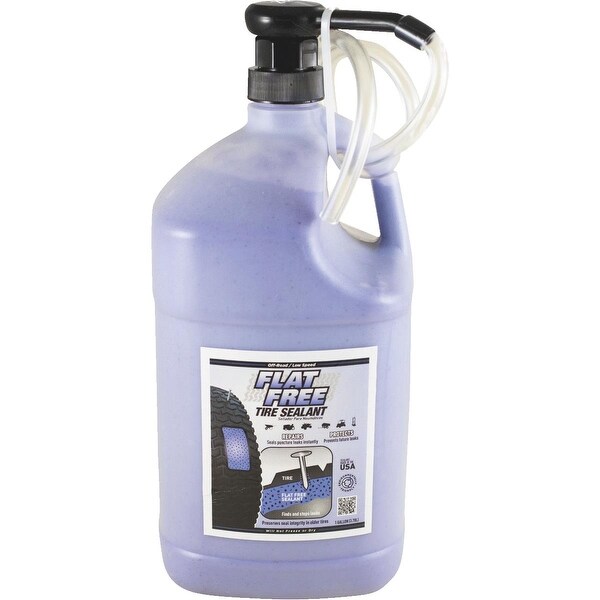Most car owners will find themselves by the side of the road with a tire failure at some point due to a screw, nail, or other sharp objects. These punctures often lead to a loss of air, which can make driving unsafe and/or impossible. If you don't have access to a spare tire and you're stranded on the side of the road due to a flat tire, there is a solution that doesn't involve calling a tow truck for help.
Tire sealants are a great way to quickly repair a slow-leaking tire, and they can also be used for preventative measures. You can easily store this product in the trunk or other area of your vehicle for emergencies. The best tire sealants are affordable and easy to use, but they're not all created equally. We did the research and found some of the best options, so you'll be prepared the next time the unexpected occurs.
Our reviews are driven by a combination of hands-on testing, expert input, “wisdom of the crowd” assessments from actual buyers, and our own expertise. We always aim to offer genuine, accurate guides to help you find the best picks.
Learn more
I took several factors into consideration when choosing the best tire sealants. First, I focused on well-known brands that have a reputation for producing high-quality products. I also looked at the effectiveness of each item. Using user testimonials as a reference, I compared how each sealant performed in real-world conditions in order to determine how well they functioned overall.
I also looked at the effectiveness of each item. Using user testimonials as a reference, I compared how each sealant performed in real-world conditions in order to determine how well they functioned overall.
I included products that are both solutions to a puncture and I made sure to pick products that can be used on a variety of different tires, from passenger cars to larger pickup trucks. I also included items in a wide range of prices to suit a variety of budgets. For more information on our methodology, go here.
Slime Emergency Tire Repair Sealant
While the name may be gross, Slime tire sealant is one of the most effective sealants on the market. It is capable of filling punctures up to 1/4-inch, which is around the size of a normal screw or nail. It’s a great preventative measure to help fight against the possibility of full tire blowouts.
This small and powerful formula is fit for cars, trucks, SUVs, ATVs, trailers, and RVs. Plus, it’s compact enough to take with you, no matter where you plan on driving. One of the best features we found is that the bottle comes with its own valve core removal tool, giving you easy access to prevent leaks in your tires.
However, if you are using it for a car or trailer, there is a restriction on how fast you should drive. It’s only effective at speeds up to 65 mph, and should only be used as a quick fix if you tend to drive at speeds around this mark.
It is capable of filling punctures up to 1/4-inch, which is around the size of a normal screw or nail. It’s a great preventative measure to help fight against the possibility of full tire blowouts.
This small and powerful formula is fit for cars, trucks, SUVs, ATVs, trailers, and RVs. Plus, it’s compact enough to take with you, no matter where you plan on driving. One of the best features we found is that the bottle comes with its own valve core removal tool, giving you easy access to prevent leaks in your tires.
However, if you are using it for a car or trailer, there is a restriction on how fast you should drive. It’s only effective at speeds up to 65 mph, and should only be used as a quick fix if you tend to drive at speeds around this mark.
This simple small yet effective tire sealant is capable of making sure a large tire holds its air until you get it properly taken care of. Its compact bottle means you can take it with you and quickly use it in case you have a tire emergency. You can easily check what tires Fix-A-Flat fits by checking out the guide on their website.
It is able to fully block a puncture up to 1/4-inch. While it isn’t a permanent fix, it will last long enough for you to drive it to the shop or back home. It’s easy to attach to your tire nozzles as well, giving you more time to get back on the road and less time worrying about how much air you’ve lost. It’s nontoxic, noncorrosive, and nonflammable as well, making it safe for the environment. It’s also safe to use on cars with a TPMS monitoring system.
While it may be fast-acting, you will have to move the car to the right position in order for the compound to take hold effectively. That means you have to make sure to park where the puncture is at the six o’clock angle, which can be difficult to do by yourself.
Its compact bottle means you can take it with you and quickly use it in case you have a tire emergency. You can easily check what tires Fix-A-Flat fits by checking out the guide on their website.
It is able to fully block a puncture up to 1/4-inch. While it isn’t a permanent fix, it will last long enough for you to drive it to the shop or back home. It’s easy to attach to your tire nozzles as well, giving you more time to get back on the road and less time worrying about how much air you’ve lost. It’s nontoxic, noncorrosive, and nonflammable as well, making it safe for the environment. It’s also safe to use on cars with a TPMS monitoring system.
While it may be fast-acting, you will have to move the car to the right position in order for the compound to take hold effectively. That means you have to make sure to park where the puncture is at the six o’clock angle, which can be difficult to do by yourself.
TireJect Tire Sealant Kit
When ordering this tire sealant, you have the option of choosing 10, 20, or 40 ounces.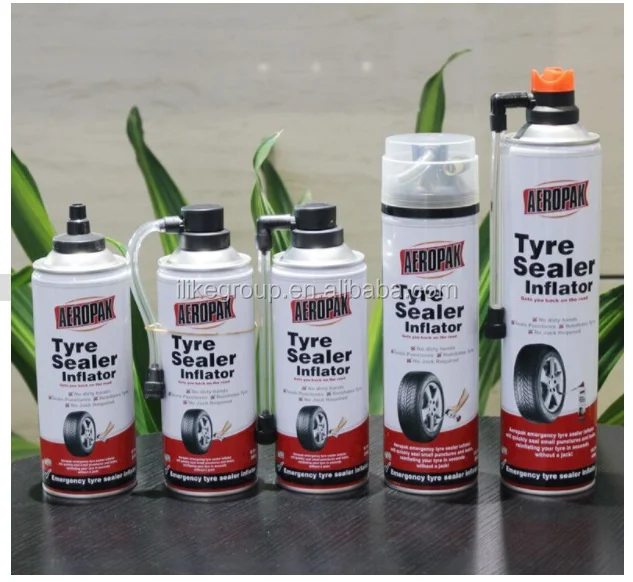 You can also choose to order a one-gallon container. The sealant is a liquid rubber mixture that contains tire particles and Dupont Kevlar fibers. Every 10 ounces of sealant comes with one bladder bag and one injector tool. You can use this repair kit to repair punctures in your tires from screws, nails, thorns, or anything else. The sealant only works on punctures that are up to 3/8-inch.
You’ll find this sealant system is easy to use, thanks to the included injector tool. You connect it to your valve stem for a mess-free installation. You can even install this sealant on all four of your tires and prevent future flats for the next year.
You can also choose to order a one-gallon container. The sealant is a liquid rubber mixture that contains tire particles and Dupont Kevlar fibers. Every 10 ounces of sealant comes with one bladder bag and one injector tool. You can use this repair kit to repair punctures in your tires from screws, nails, thorns, or anything else. The sealant only works on punctures that are up to 3/8-inch.
You’ll find this sealant system is easy to use, thanks to the included injector tool. You connect it to your valve stem for a mess-free installation. You can even install this sealant on all four of your tires and prevent future flats for the next year.
Ride-On Motorcycle Tire Balancer & Sealant
This tire sealant is meant for use with motorcycle tires.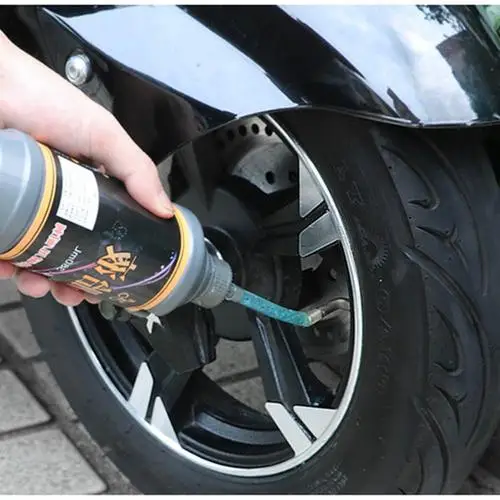 It will balance and seal your tire by evenly coating the inside surface of your tire. If your tire suffers a puncture while you’re riding, the centrifugal force of your rotating tire and the internal air pressure will move the Ride-On sealant into the hole. This will instantly seal it. This will work on punctures that are up to 1/4-inch in tubeless tires and 1/8-inch in tube tires.
You’ll like that this sealant turns your tires into self-sealing tires. They’ll also eliminate the need for ugly wheel weights. This sealant is specifically designed for use in high-speed tires. It’ll improve the performance of your motorcycle tires by dampening road vibration and noise.
It will balance and seal your tire by evenly coating the inside surface of your tire. If your tire suffers a puncture while you’re riding, the centrifugal force of your rotating tire and the internal air pressure will move the Ride-On sealant into the hole. This will instantly seal it. This will work on punctures that are up to 1/4-inch in tubeless tires and 1/8-inch in tube tires.
You’ll like that this sealant turns your tires into self-sealing tires. They’ll also eliminate the need for ugly wheel weights. This sealant is specifically designed for use in high-speed tires. It’ll improve the performance of your motorcycle tires by dampening road vibration and noise.
Berryman Products Seal R Tire Sealing Compound
This tire sealant comes in a variety of sizes based on your needs: 8, 16, or 32 ounces or a one-gallon container. It will instantly seal your pneumatic tires and tubes. It protects against thorns, screws, and any other sharp objects. To use, extend the included hose and attach it to your tire valve. Then use the reliable pump action nozzle to dispense the sealant into your tire.
What’s nice about this sealant is that it specifically states that it’s safe for use with a variety of metals. This includes chrome, steel, and alloys used in wheel making. You can confidently use this sealant without worrying that it will ruin your wheels. It also stays liquid and won’t corrode or cause rust.
It will instantly seal your pneumatic tires and tubes. It protects against thorns, screws, and any other sharp objects. To use, extend the included hose and attach it to your tire valve. Then use the reliable pump action nozzle to dispense the sealant into your tire.
What’s nice about this sealant is that it specifically states that it’s safe for use with a variety of metals. This includes chrome, steel, and alloys used in wheel making. You can confidently use this sealant without worrying that it will ruin your wheels. It also stays liquid and won’t corrode or cause rust.
Slime Smart Spair Emergency Tire Repair Kit
The Slime 50107 Kit contains two distinct elements: a powerful tire inflator and the emergency tire repair sealant.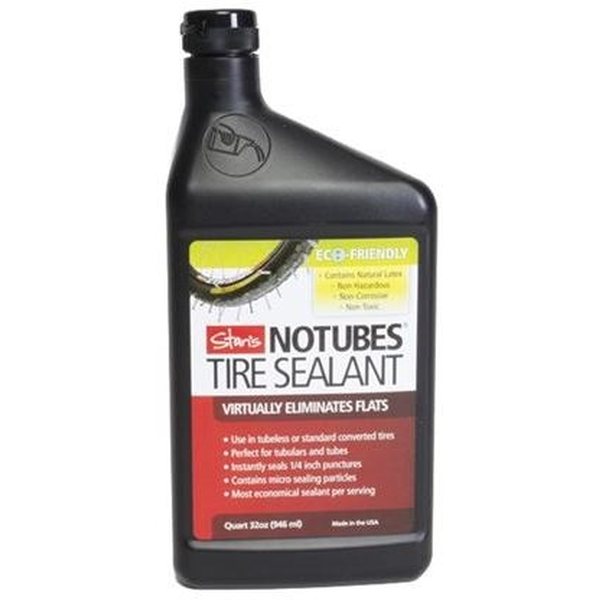 Instead of having to use a jack to change out the punctured tire, leave that hassle behind. The sealant is tire sensor safe and works well with standard car tires. The Slime tire sealant repairs tread area punctures up to 1/4-inch in diameter. Along with the kit’s included inflator, you can repair and inflate the tire within 15 minutes. Simply plug the tire inflator into your vehicle’s 12-volt accessory power outlet to get it started. It features a quick connect air hose and a built-in tire pressure dial gauge. The 16-ounce bottle of the emergency non-toxic tire sealant instantly seals punctures. The process is simple and hassle-free.
However, some users have experienced issues with the product going dead and not working when they needed it. Some actually lost more air after using this sealant.
Instead of having to use a jack to change out the punctured tire, leave that hassle behind. The sealant is tire sensor safe and works well with standard car tires. The Slime tire sealant repairs tread area punctures up to 1/4-inch in diameter. Along with the kit’s included inflator, you can repair and inflate the tire within 15 minutes. Simply plug the tire inflator into your vehicle’s 12-volt accessory power outlet to get it started. It features a quick connect air hose and a built-in tire pressure dial gauge. The 16-ounce bottle of the emergency non-toxic tire sealant instantly seals punctures. The process is simple and hassle-free.
However, some users have experienced issues with the product going dead and not working when they needed it. Some actually lost more air after using this sealant.
STP Car Tire Fix Sealant and Tire Inflator
Whether you drive a car or truck or ride a motorcycle, STP Tire Fix Sealant and Inflator works well without any tools required. The non-flammable formula seals punctures that are up to 1/4-inch in diameter, it is easy to clean up with water, and it will hold air for as long as three days.
The product is also safe to use with tire pressure monitoring sensors. We like that this product is so easy to use: just fill up the tire to seal and inflate it, and go. Sixteen ounces fills a standard-sized tire, while 20 ounces fills larger tires. Overall, it's great for emergencies and is a short-term solution. The company recommends going to a repair shop for inspection and a permanent fix within a couple of days after application.
The non-flammable formula seals punctures that are up to 1/4-inch in diameter, it is easy to clean up with water, and it will hold air for as long as three days.
The product is also safe to use with tire pressure monitoring sensors. We like that this product is so easy to use: just fill up the tire to seal and inflate it, and go. Sixteen ounces fills a standard-sized tire, while 20 ounces fills larger tires. Overall, it's great for emergencies and is a short-term solution. The company recommends going to a repair shop for inspection and a permanent fix within a couple of days after application.
Slime Emergency Tire Repair Sealant is well-known in the industry and can repair screw or nail punctures up to 1/4-inch long. It can be used on cars, trucks, SUVs, ATVs, RVs, and more. It includes a valve core removal tool to make the process easier. For a slightly more budget-friendly option, consider the equally effective Fix-A-Flat Tire Sealant and Car/SUV Tire Inflator.
For a slightly more budget-friendly option, consider the equally effective Fix-A-Flat Tire Sealant and Car/SUV Tire Inflator.
Aerosol tire sealant is one of only two types. A single-use product, aerosol sealant is for emergency repairs that will allow you to drive short distances on a punctured tire. It comes in a bottle that sprays, allowing a simple application to fill holes in the tire with great accuracy. When you spray the product into the valve, the punctured tire will inflate. The formula coats the inside of the tire to plug any leaks or holes.
The second type of sealant for a punctured tire comes in the form of a thick gel. Using the gel option can be a bit more difficult than the aerosol tire sealant, as it is harder to put in place. Plus, it can be messier due to its slimy substance. To use the gel sealant, you will usually need tools or equipment to make sure the tire is properly sealed and no longer leaking air.
Using the gel option can be a bit more difficult than the aerosol tire sealant, as it is harder to put in place. Plus, it can be messier due to its slimy substance. To use the gel sealant, you will usually need tools or equipment to make sure the tire is properly sealed and no longer leaking air.
Many tire sealants are very affordable and cost between $10 and $20. These products are often at least 16 ounces in size and work as promised. They are no-frills, but they get the job done. If you spend upwards of $60, you will often find much larger sealant containers or those that are part of a kit, which can include items such as tire inflators. If you have room in your vehicle for a kit, it may be worth storing one in your trunk due to the added features, such as accessories for inflatable and carrying bags.
You’ve got questions.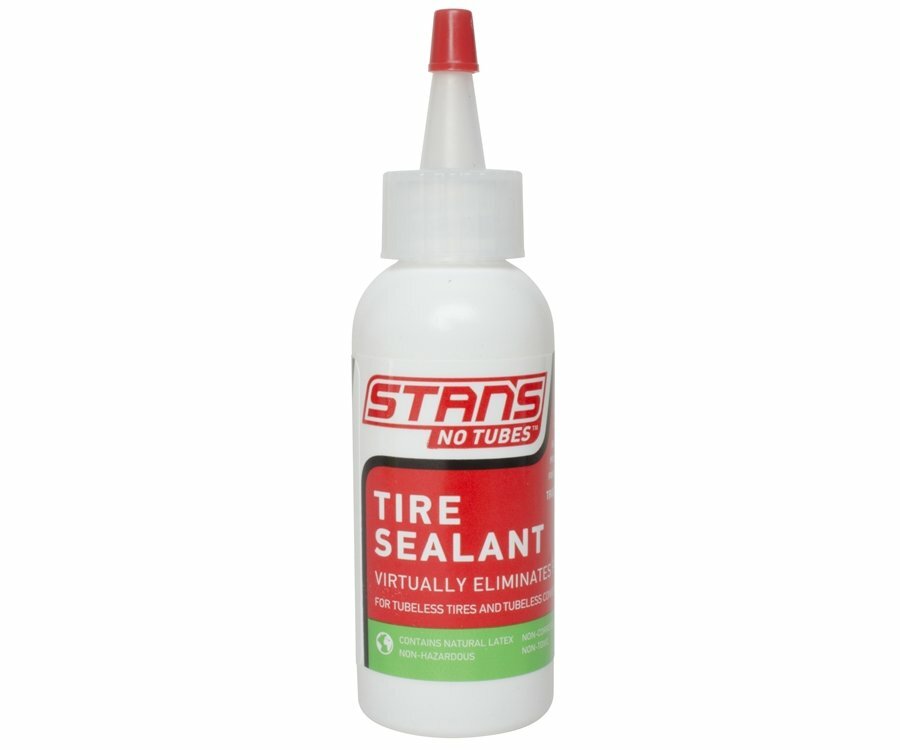 The Drive has answers.
The Drive has answers.
Tire sealants are for temporary use and not a permanent solution. The tire sealant’s purpose is to get you to the nearest gas station, automotive shop, or dealership to fix the tire. Depending on the amount of damage to the tire, you may need to get a brand-new tire put on the vehicle.
Tubeless tire sealant should last an average of two-six months. However, the life span depends on several factors, such as temperature, humidity, driving frequency, tire casing thickness, and the number of punctures.
This depends on the type of tire sealant and the brand. Each product should state how long they last, but generally they can last up to two years before needing to replace the tires.
A: This varies on the size of the tire you are trying to fill the puncture in.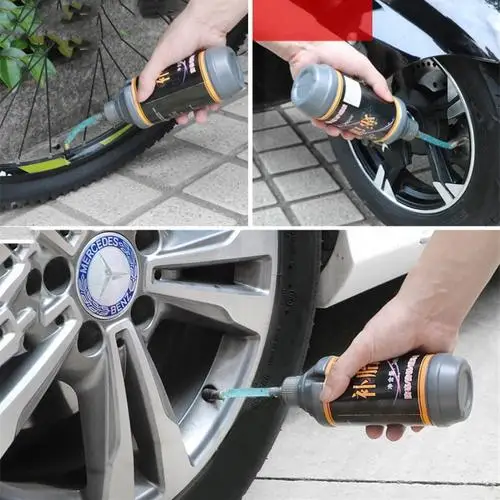 A lawn mower tire is smaller and therefore doesn’t need that much product. However, a Jeep tire is larger and will typically need an entire bottle of tire sealant.
A lawn mower tire is smaller and therefore doesn’t need that much product. However, a Jeep tire is larger and will typically need an entire bottle of tire sealant.
A: You inject the tire sealant through the valve or tire nozzle. After completing that step, you then fill the tire with air until it is at the required amount.
Welcome to the Thomas guide to the best tire sealants 2022. Thomas has been connecting North American industrial buyers and suppliers for more than 120 years. When you purchase products through our independent recommendations, we may earn an affiliate commission.
Tire sealants are nifty products to have around in case of a flat tire or slow leak and should be part of an emergency tool kit for mountain bikers, ATVs, or any vehicle with off-road tires. Keep in mind that the centrifugal force can become off balance when the sealer is added to the tire until it's evenly distributed. To do this, simply allow the wheel to turn for several minutes slowly.
Keep in mind that the centrifugal force can become off balance when the sealer is added to the tire until it's evenly distributed. To do this, simply allow the wheel to turn for several minutes slowly.
Image credit: Shutterstock/Mon Ster
Most sealers are not intended for highway use, although some brands can be used as soon as the sealer is properly distributed inside the tire to reduce any wobble. Certain factors such as location, which affect surface temperature and the tire quality of the vehicle, also affect intended usage. If unsure exactly how to distribute the sealer inside the tire, search the web for videos explaining this critical step.
Most car tire sealers are designed for emergency use and will last long enough to get drivers to the nearest mechanic. Keeping a sealer and air compressor handy in your car to plug a hole can save time spent changing a spare tire.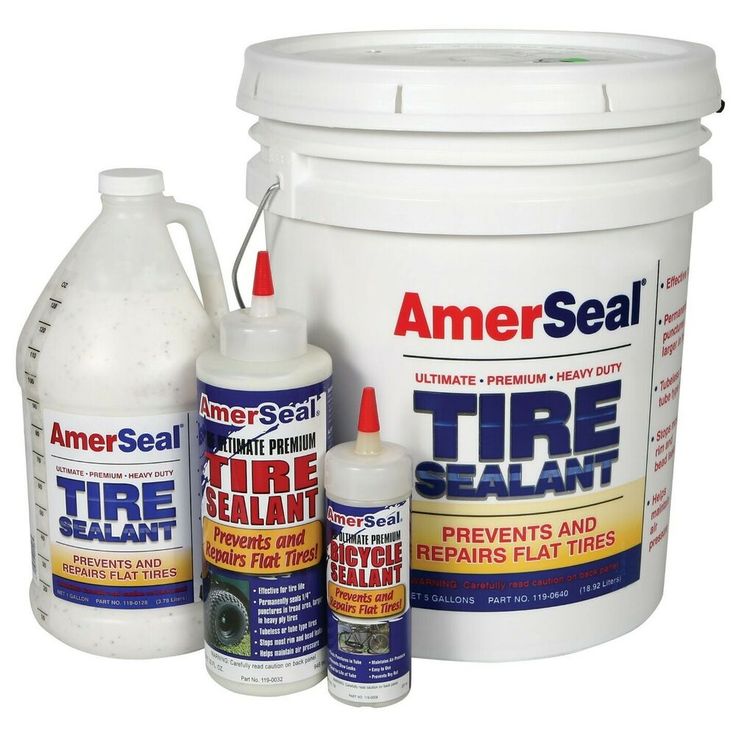 On the other hand, bike sealers can be used as a shield to help prevent thorns or other sharp items from puncturing tires. Below is a list of different sealers and their specific uses.
On the other hand, bike sealers can be used as a shield to help prevent thorns or other sharp items from puncturing tires. Below is a list of different sealers and their specific uses.
Intended as a short-term solution for a slow leak to get you to the nearest gas station, aerosols are not as durable as other sealants. These sealants are highly flammable and also should not be stored in areas that have a temperature of over 120°F. Most have carcinogens and ingredients that deplete the ozone layer and are recommended only for a quick fix to a punctured tire.
Any sealer that comes in liquid form is a liquid sealer. Some common materials used in liquid sealers are latex or rubber, aramid, or kevlar fibers. They are inserted into the tire using an injector and special valves.
This is one of the most commonly used sealers for bike wheels due to its quality and performance. This sealant is injected into a wheel in liquid form to fill holes and punctures. Once the holes are sealed, the liquid plugs the space between the tire and the rim.
This sealant is injected into a wheel in liquid form to fill holes and punctures. Once the holes are sealed, the liquid plugs the space between the tire and the rim.
A type of liquid sealer, latex simply refers to the primary material used in the sealant. People who are allergic to rubber should either avoid this type of sealer or use gloves to prevent skin contact.
Secure a hole in a car, truck, or bike tire with one of these tried and true tire sealers.
Best Non-Toxic Tire Sealant: Slime 10011 Tire Sealants | Buy Now Best Tubeless Tire Sealant: Stan’s NoTubes Tubeless Sealant | Buy Now Best Liquid Tire Sealant: TireJect Car Liquid Sealants Kit | Buy Now Best Aerosol Tire Sealant: Fix-A-Flat S60420 Aerosol Sealants | Buy Now Best Heavy-Duty Vehicle Tire Sealant: TireJect Truck Sealants | Buy Now Best Non-Corrosive Tire Sealant: Slime Sealant | Buy Now Best Latex Tire Sealant: Truckerco Sealant | Buy Now Best Performance Tire Sealant: ORANGE Seal Sealer | Buy Now Best Compound Tire Sealant: Berryman Sealant | Buy Now Best Contact Tire Sealant: FlatOut 20110 Sealant | Buy NowReview our list of the best sealants to balance air pressure in an emergency for bikes, cars, or larger automobiles.
*Prices listed in this article were as shown in US$ on Amazon.com (USA) as of January 2022
Instantly seal leaks with this Slime repair quality sealant. One bottle should work as a tire patch for 20 bicycle tires. It can be used on cars or small SUVs for up to 100 miles before needing repair. It also has effectiveness in cold weather. Some customers noted that the included valve core removal tool wasn’t the best, but the sealant itself was excellent value for money.
“This sealed a nail hole in my tire,” explained one shopper. “This is the first time in decades of experience, and through countless flat tires, I have ever seen an over-the-counter tire repair sealant work.”
At the first sign of a puncture or low pressure, this bottle of Stan’s sealer liquid works on contact.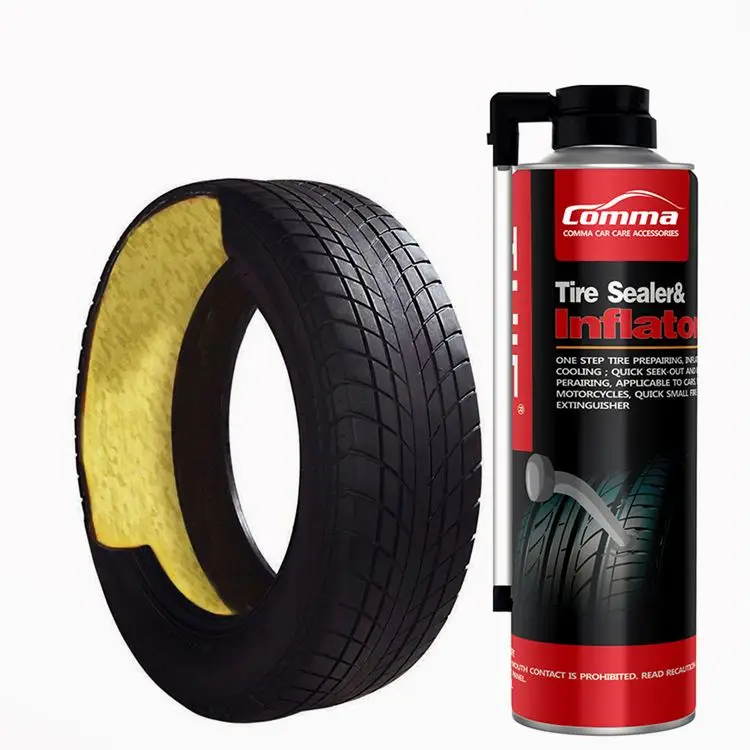 Injected into bike tires ahead of time, it works very well for tires that go over sharp objects like rocks or cacti when off-road. Additional features include working on high or low-pressure tires, on the highway, or even in cold weather.
Injected into bike tires ahead of time, it works very well for tires that go over sharp objects like rocks or cacti when off-road. Additional features include working on high or low-pressure tires, on the highway, or even in cold weather.
If in doubt about exact tire specs, be sure to check Stan’s website. “Love Stan’s no tubes sealant,” raved one buyer. “I have been using it with my tubeless application for two years with no flats to report.”
Designed for use in cars or smaller SUVs, this TireJect sealer will come in handy in an emergency and can be used for drills that are ¼-inch or smaller. The manufacturer suggests that customers connect the valve stem to the bottom of the tire and gently inject the product into the tire for best results.
All tools needed to remove the tire valve are included with the package.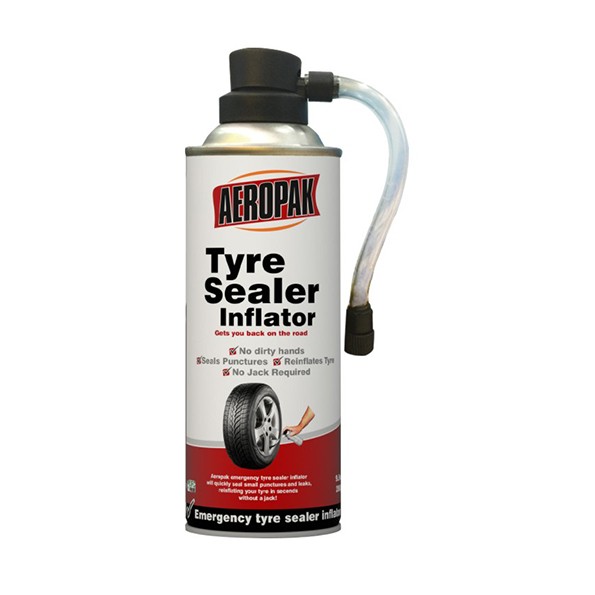 One purchaser described, “TireJect worked fantastic on three cars that [had] leaking tires. After insertion of TireJect into each, [there were] no air leaks whatsoever.”
One purchaser described, “TireJect worked fantastic on three cars that [had] leaking tires. After insertion of TireJect into each, [there were] no air leaks whatsoever.”
Intended for emergency use, this spray from Fix-A-Flat works on contact with holes that are less than ¼-inch long. The ecological formula is less toxic than the standard aerosol tire sealants, which is good news for both you and the environment. This sealer lasts up to 100 miles after application.
Be sure to check the company’s website to see which of the four sizes is appropriate for specific car sizes. “It really works,” expressed one consumer. “I keep one in my car and one in my wife’s car at all times. This will get you off the side of the road and to a service station. Super easy to use.”
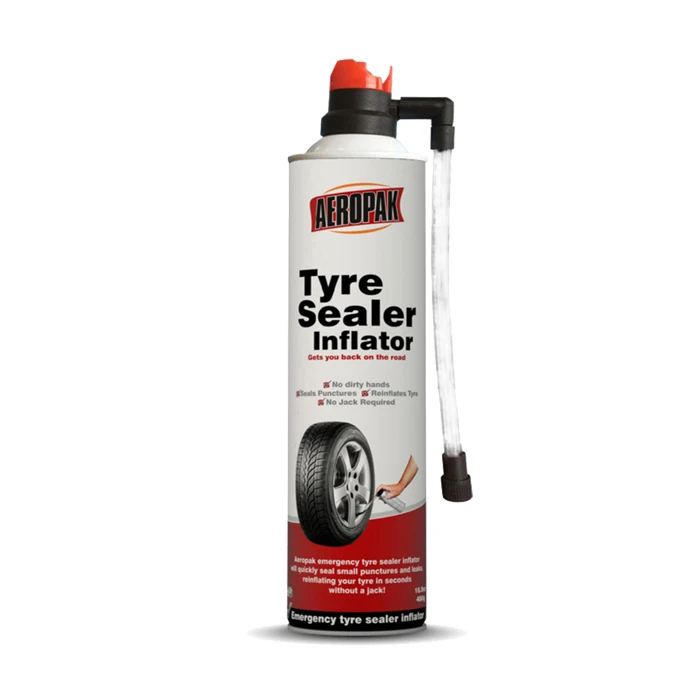 39), Amazon
39), Amazon Suitable for a truck with thicker tires, this liquid rubber TireJect sealer can replace the need to install a spare tire in emergency conditions. Tools included are a dispensing cap, metal valve remover, and stem cap. Use only the recommended amount to cover small beads or tread punctures to ensure the correct pressure.
One happy customer reported, “I knew it worked great in my UTVs, and it worked equally as well in my ½-ton truck tire. One pouch sealed up the leak, and it hasn't budged since, through both hot and cold weather.”
Useful to plug nails or other punctures in tires, this Slime sealant was one of the highest-rated sealers for its ability to seal tires for up to two years. It even works well on alloys or rust, whether in a hot or cold area that reaches -35°F. If in doubt about how to connect the valve, Youtube has several helpful video instructions.
It even works well on alloys or rust, whether in a hot or cold area that reaches -35°F. If in doubt about how to connect the valve, Youtube has several helpful video instructions.
One shopper who mows over the thorns of water locust trees and has used many other unsuccessful sealers on their mowers, explained, “Since putting this stuff in all my mowing and bush-hog equipment, I have not had to even add air to any of their tires, and that has been two years now.”
Customers who live in areas that experience extreme cold or hot temperatures and drive over rough terrain will appreciate the usefulness of this Truckerco sealer. The cream formula won’t freeze in temperatures of up to 10°F and won’t dry out either.
It can be used for smaller tires such as those on bicycles, UTVs, ATVs, or lawnmowers. One customer expressed, “The cool thing is that it has a ton of latex in the solution, so when punctures occur, it has quickly sealed what would be considered ride-ending punctures if using other brands.”
One customer expressed, “The cool thing is that it has a ton of latex in the solution, so when punctures occur, it has quickly sealed what would be considered ride-ending punctures if using other brands.”
Over 96% of Amazon customers loved the performance and endurance of this Orange Seal tubeless sealer. Available in three different sizes, from four to 16 ounces, this rubber-based formula works quickly to plug holes and lasts for 120 days.
Their website has a complete listing of correct dosages for different tire sizes and how to connect valves properly. One cyclist reviewed, “What I like best about Orange Seal is the bond at the bead which is so solid, it makes re-inflation simple. I find that invaluable on the trail.”
This Berryman sealer is top-notch for pneumatic tires and tubes that regularly ride over rough terrain full of sharp objects.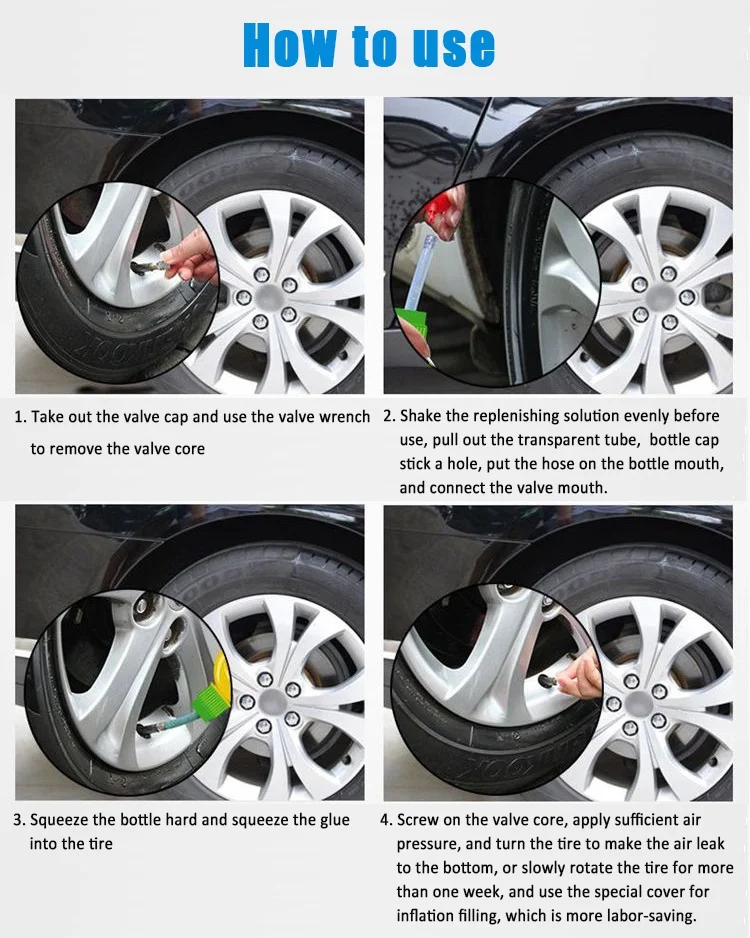 Even in extreme weather conditions, it remains liquid and works on even sensitive aluminum wheels.
Even in extreme weather conditions, it remains liquid and works on even sensitive aluminum wheels.
Simply connect the included pump to the tire and pour the liquid slowly into the tube. One reviewer who had a steady leak on their ATV used this and, six months later, wrote, “Amazing! I still have not had to put air in tires that I sealed with this.”
The performance of this kevlar enforced formula from FlatOut is highly rated and easy to use, even for larger holes. It can seal punctures up to ½-inch wide and should only be used for off-road applications. It is suitable for smaller vehicles like bikes, ATV/UTVs, dirt bikes, riding lawn mowers, golf carts, and boat trailers, and not for cars or trucks.
Able to work in temperatures of -30°F and over 104°F, this is a versatile and robust rubber-free sealer. One reviewer commented, “This stuff seals up some pretty large holes and stops slow leaks instantly. Better than tire liners, better than the ‘other’ slimy stuff, and maybe even better than the super-expensive tire ‘armor’ products.”
One reviewer commented, “This stuff seals up some pretty large holes and stops slow leaks instantly. Better than tire liners, better than the ‘other’ slimy stuff, and maybe even better than the super-expensive tire ‘armor’ products.”
Slime’s non-toxic tire sealer (US$8.97, Amazon) received consistently high reviews for cars or small trucks and works well in emergencies. For bikes, ATVs, or other off-road only applications, the kevlar enforced FlatOut tire sealer that is also rubber-free was the most versatile in extreme temperatures and is incredibly long-lasting (US$14.97, Amazon).
We hope our review of the best tire sealant has been helpful. For more suppliers of related products, including tire repair, foam sealants, mounting lubricants, and eco-sealants, consult our additional guides, or visit the Thomas Supplier Discovery Platform.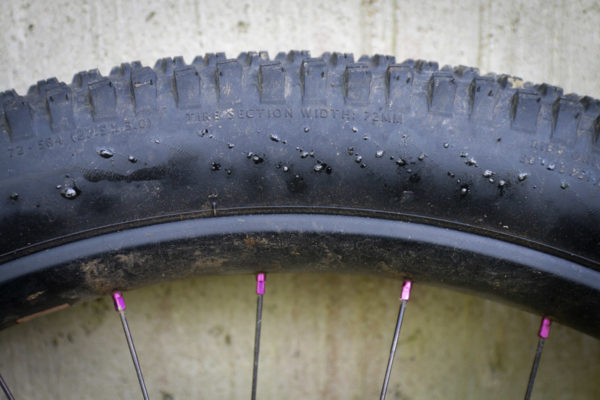
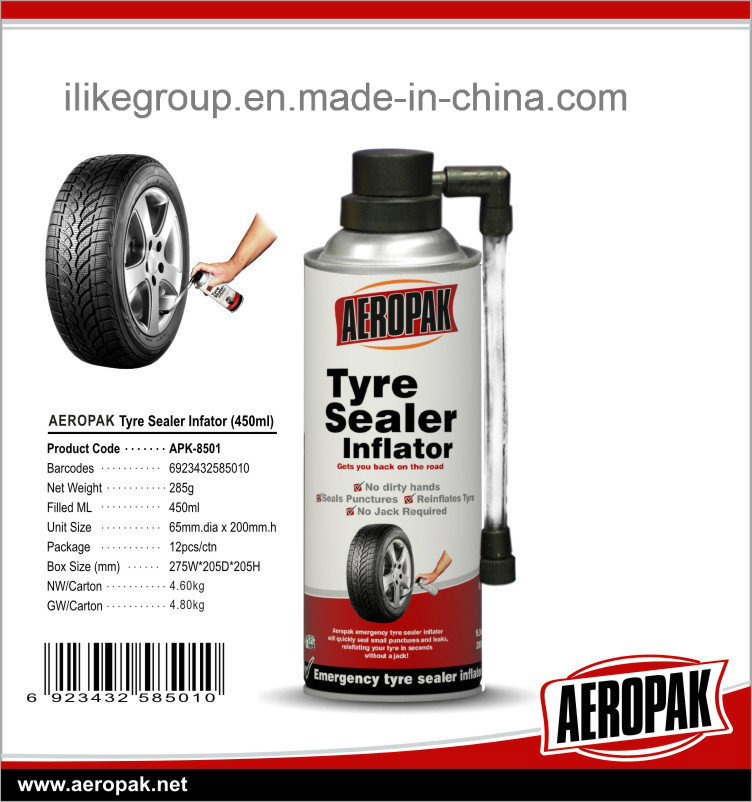 S.A
S.A KEVLON anti-puncture is a tire life extension product. Tire sealant is a chemical solution that is injected into a tire to provide permanent protection against air leakage throughout the life of the tire and to increase tire life.
Tire sealant is a chemical solution that is injected into a tire to provide permanent protection against air leakage throughout the life of the tire and to increase tire life.
Learn more at What is Kevlon Sealant?
KEVLON Sealant has a shelf life of 5 years. But in practice, there were cases when KEVLON brand products were kept by thrifty drivers for 8 years and then were used for their intended purpose.
Yes, it is mandatory. Remove the object from the tire, check the air pressure in the wheel, after overcoming a certain distance, check the pressure in the wheel again.
yes, KEVLON sealant is guaranteed for one year. KEVLON sealant does not affect the tire manufacturer's warranty. In fact, KEVLON sealant even exceeds the tire manufacturer's warranty requirements.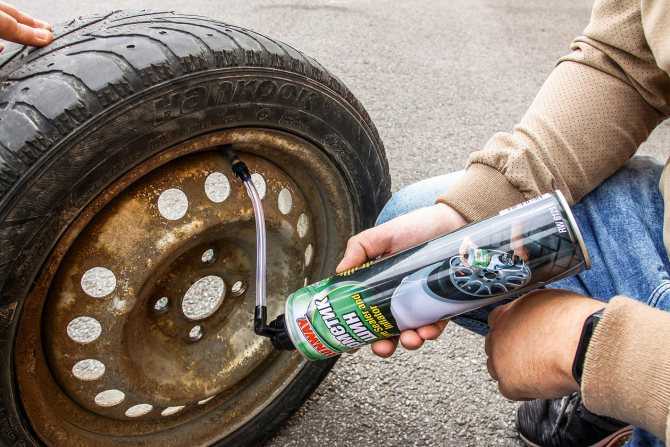
KEVLON sealant warranty means that:
Your tires will never deflate due to a puncture less than 6.35 mm in diameter for the High Speed series and a puncture in diameter less than 20 mm for the Off Road series in the tread area for the entire duration of normal tire life.
Your tires will never deflate due to porosity and rubber delamination;
KEVLON Sealant will keep the air in the tires and provide permanent protection.
Our clients are varied. KEVLON tire sealant is used by construction companies, police, municipal organizations, truck fleets, mining companies, industrial organizations, utilities, new car dealers, used car dealers, private owners.
liquid tire sealants are generally paste, solvent, latex based and freeze at temperatures below -10°C.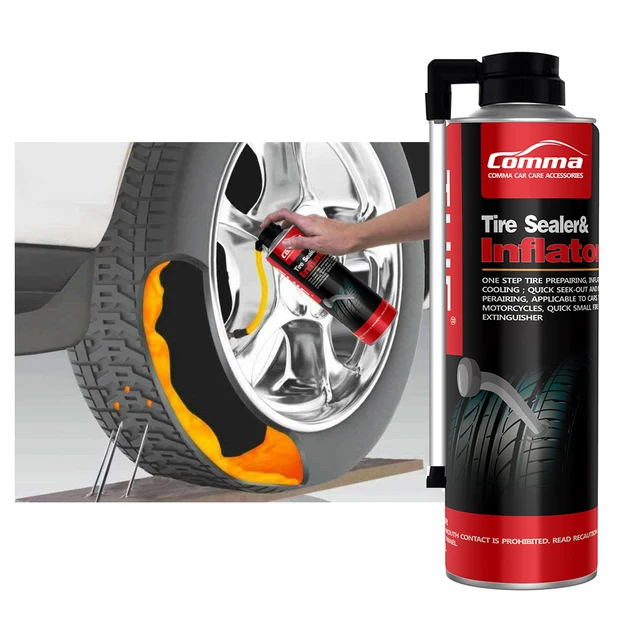 Many liquid tire sealants cure and cause imbalance and damage to the rubber compound. And this, in turn, reduces the life of the tire. KEVLON anti-puncture sealant is based on ethylene glycol and will not deteriorate or dry out inside the tire. KEVLON Sealant, when properly filled, will keep the wheel balanced.
Many liquid tire sealants cure and cause imbalance and damage to the rubber compound. And this, in turn, reduces the life of the tire. KEVLON anti-puncture sealant is based on ethylene glycol and will not deteriorate or dry out inside the tire. KEVLON Sealant, when properly filled, will keep the wheel balanced.
See the Glycol vs. Latex page for tire sealant differences
aerosol products are latex based and should only be used after a tire has been punctured. And even then they seal the puncture temporarily. After applying such a sealant, the tire will still need to be taken to a workshop for repair, where it will be dismantled, the sealant removed, the puncture sealed and installed back. And all this at the expense of the user.
KEVLON Tire Sealant is an ethylene glycol-based preventative designed to increase tire life. It is non-flammable and non-explosive. KEVLON sealant does not harden inside the tire and maintains balance. The KEVLON anti-puncture device is capable of operating in a wide temperature range down to -50°C. up to +150°С
It is non-flammable and non-explosive. KEVLON sealant does not harden inside the tire and maintains balance. The KEVLON anti-puncture device is capable of operating in a wide temperature range down to -50°C. up to +150°С
KEVLON High Speed Sealant is sold in 20 liter cans.
KEVLON Off Road Sealant as an emergency sealant for passenger cars in 1.25l bottles. And also for special equipment in canisters of 5, 25 and 200 liters.
yes. KEVLON brand products are a registered European trademark.
Air escaping from the tire draws the sealant into the hole. The fibers and liquid accumulating in the hole seal the puncture.
yes. KEVLON Sealant covers the hole area after removing the item from the tire. The wheel must remain on the vehicle so that when rotated, the hole expands and passes the KEVLON sealant into itself. If you do not start driving immediately after removing the object from the tire, the tire may flatten.
The wheel must remain on the vehicle so that when rotated, the hole expands and passes the KEVLON sealant into itself. If you do not start driving immediately after removing the object from the tire, the tire may flatten.
no, KEVLON sealant is a homogeneous mixture with ingredients combined in such a way that they cannot settle to the bottom. This fact is a big advantage over other water based or latex based sealants.
No. KEVLON tire sealant is chemically inert.
KEVLON Tire Sealant has been tested at -60°C (the lowest test temperature under these laboratory conditions) and has not frozen. It should also be noted that the sealant remains in a stable state when the tire is very hot, leading to tire damage.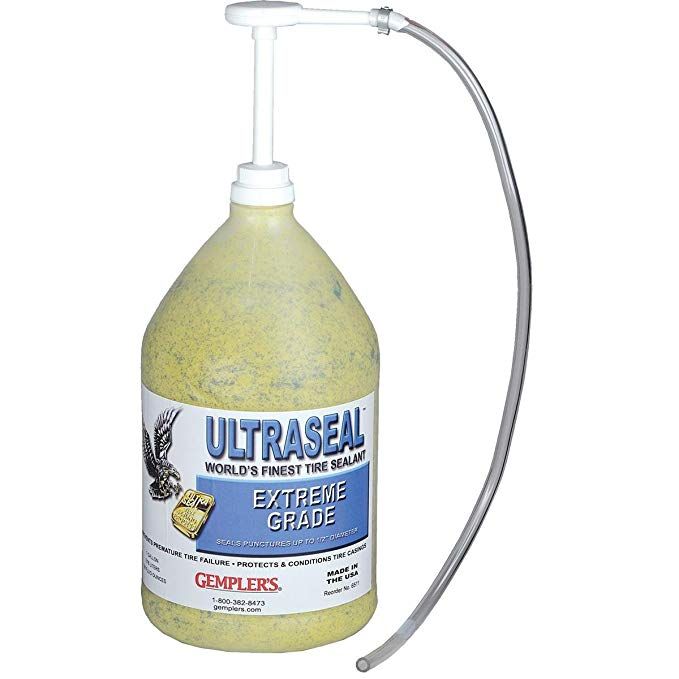
yes, because KEVLON sealant does not chemically bond to the tire, it can be easily washed off with a hose. This is an important point as the tire can be washed, retreaded and welded on after using KEVLON sealant. In addition, if a tire puncture is too large, which cannot be repaired with KEVLON sealant, it can be washed, repaired and refilled with KEVLON.
Does not call. KEVLON Sealant contains anti-corrosion additives to prevent corrosion and eliminate existing corrosion.
HIGH SPEED Series Sealant - no, Off Road Series - yes. They have different specifications and different areas of application. KEVLON High Speed Sealant contains specially selected adhesive additives to prevent runoff. The sealant stays in place and coats the inside of the tire all the time, whether the wheel is spinning or not.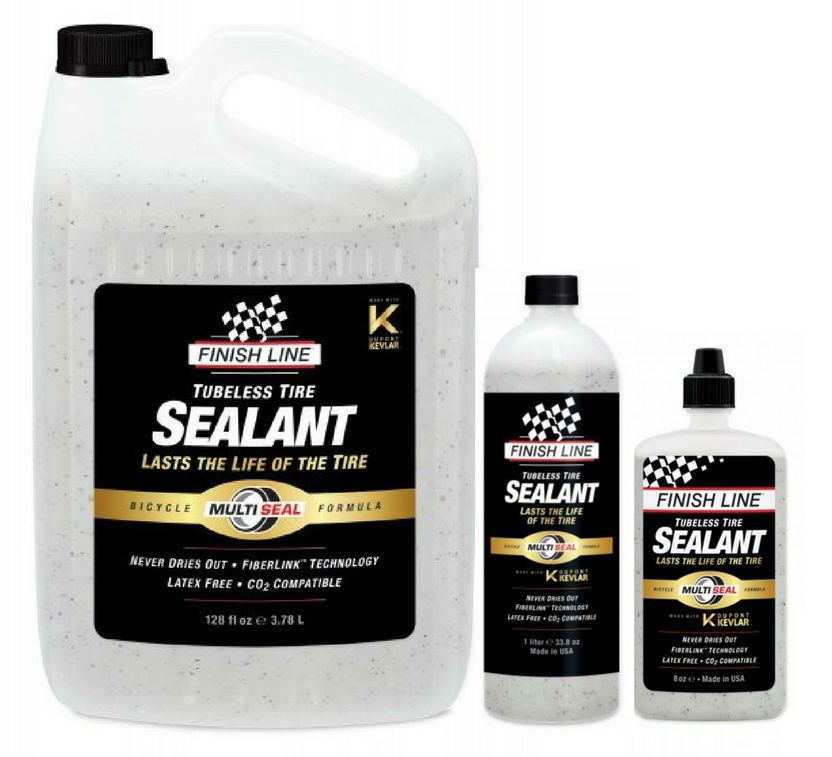 To fully distribute KEVLON High Speed Sealant to the inner surface of the tire, it is necessary to drive about 20 km at the highest possible speed.
To fully distribute KEVLON High Speed Sealant to the inner surface of the tire, it is necessary to drive about 20 km at the highest possible speed.
no. KEVLON Sealant can seal a puncture, but the sidewalls of the tire are subject to severe bending and deformation. In case of lateral damage, the tire must be disposed of.
no. The cork will be elastic. It was deliberately designed this way as tires are prone to flexing and a solid cork (repair with harnesses) will not be able to flex with the tyre, which in turn will cause air to leak.
no. KEVLON Tire Sealant always stays in the same condition it was in when it was put into the tire, as the tire is a closed vessel with no liquid and no chance of evaporation.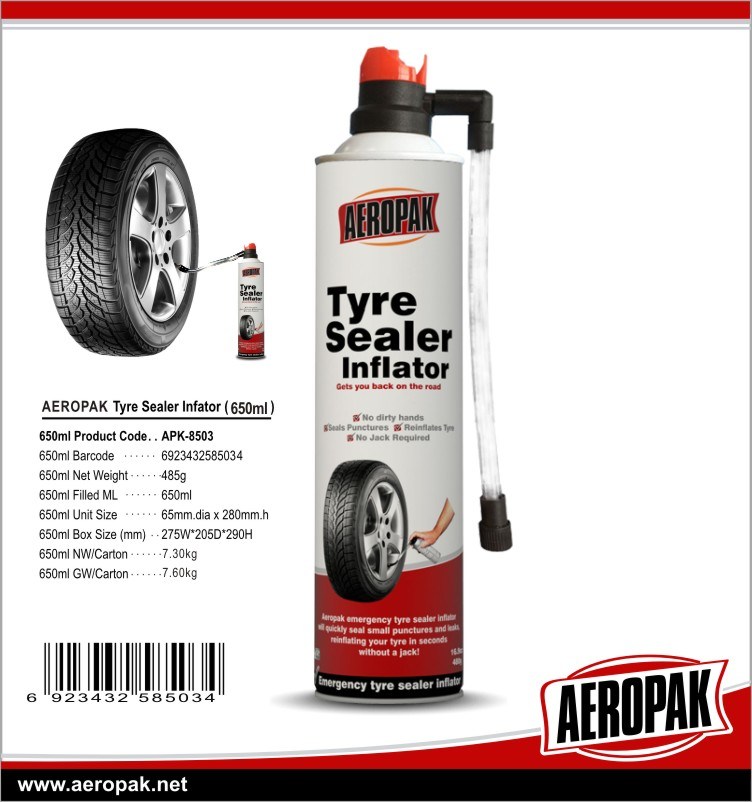
this is possible, but rarely occurs if polymer particles get into the nipple and create a plug in it. In such a situation, blow out the nipple to remove the plug. If air does not enter the tire, clean the nipple with improvised means or flush it with water.
no, tire pressure must not exceed 3.0 bar. After the introduction of KEVLON anti-puncture, the tire must be inflated to operating pressure. Or use a PERSOL pneumatic pump to charge the sealant.
yes, this requires high-tech equipment, which is used in mining enterprises operating super-heavy dump trucks. In this situation, it is not necessary to deflate the tires before applying KEVLON Tire Sealant.
the following tools are required:

no. KEVLON tire sealant is non-flammable. It is based on glycol, in other words, antifreeze. Antifreeze does not burn.
no. KEVLON Sealant is environmentally friendly, non-flammable, non-toxic and non-explosive. Not to drink. Keep away from children.
yes. After application, KEVLON anti-puncture remains in a liquid state for the entire period of operation of the tire and wheel. As the wheel rotates, the centrifugal force distributes the solution evenly over the inside of the tire. With any puncture, thousands of closure fibers will seal the hole and prevent air from escaping. Such actions will be repeated with each puncture.
KEVLON Tire Life Extender is injected quickly and easily through the nipple using a metering pump (average injection time into the tire is only a few minutes).
yes, but for older tires, apply 10-15% more KEVLON sealant than indicated in the table. Due to the presence of open pores in the old tire, a certain amount of KEVLON anti-puncture will be absorbed.
KEVLON Sealant should only be used on pneumatic tyres. KEVLON Sealant can be used in tube and tubeless tyres.
Check with Kevlon staff at [email protected]
Or use the online chat in the lower right corner of the site.
Depending on the brand of the pump, contact the supplier of the product for details.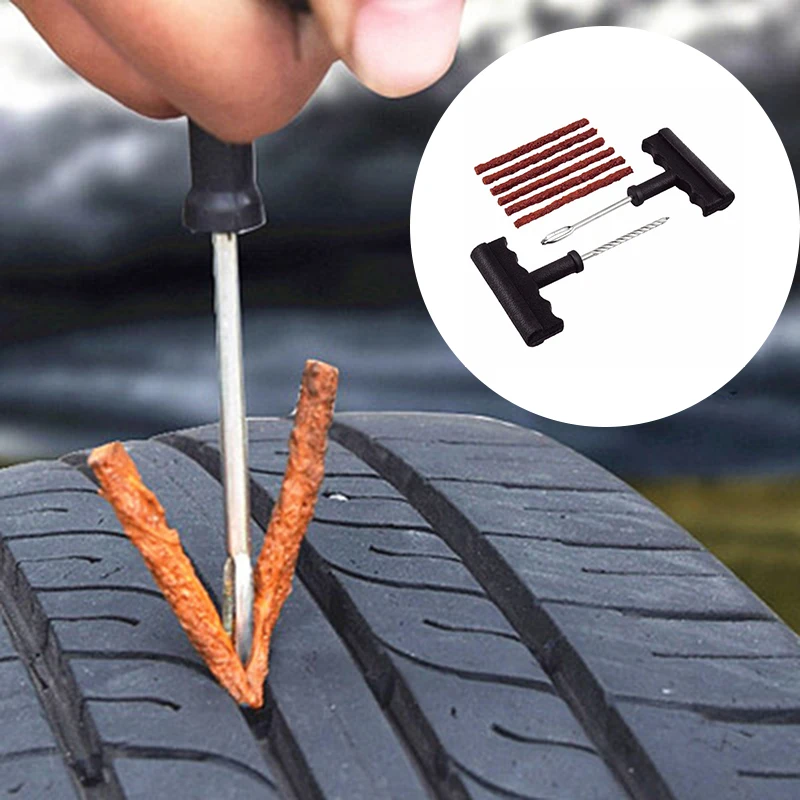 Proper operation of the pump is in the VIDEO section of this website.
Proper operation of the pump is in the VIDEO section of this website.
this is impossible to predict, since the answer depends on many factors, namely the hole size, air pressure, surface area, as well as the moment of puncture (whether in motion or not), tire size and the amount of sealant poured
With multiple punctures, there is a high chance that a large amount of sealant will come out and the air pressure will decrease to a level at which it will no longer be possible to ensure a good sealing of the punctures. In this case, the wheel will need to be filled with KEVLON anti-puncture again.
this is possible if the pressure gauge is used incorrectly, the tightness is not ensured and air escapes. You should not hear air leaks while measuring pressure.
Ask us in online chat
Open a chat
A company specialist will give detailed advice
Request a call
A car tire puncture is an unpredictable phenomenon. A spare or stowaway will of course help, but in some cases a faster method of troubleshooting may be required. For girls, changing a wheel can be a serious test. In such situations, a special material - tire sealant - can become a reliable means of repairing a puncture.
In most cases, tire sealant is an aerosol can containing a special chemical material that seals the tire from the inside.
The composition of the sealants are:
The latex sealant works from the inside of the tire. The material covers the inner surface, and getting to the place of breakdown, isolates it. Compositions based on synthetic or natural fibers are made on the basis of asbestos, polyethylene or paper. They, unlike latex sealants, act only at the puncture site itself.
Compositions based on synthetic or natural fibers are made on the basis of asbestos, polyethylene or paper. They, unlike latex sealants, act only at the puncture site itself.
By appointment means for tires are preventive and repair.
Means for preventive purposes are used in order to prevent a possible breakdown of rubber. A special sealing compound is fed through the nipple into the tire.
Under the influence of centrifugal force, which occurs when the vehicle is moving, the material is distributed over the inner surface of the tire.
When a tire breaks down, into which a preventive sealant is poured, there is no pressure drop in the wheel.
If the tire is with a chamber, then the composition is poured between the balloon and the tread layer. Due to the air cushion that is present in the wheels with the camera, heating can occur. Since the material withstands high temperatures, it contributes to the cooling of the tread. When using a preventive sealant in tubeless tires, the composition is distributed inside the wheel and prevents the occurrence of punctures and cracks.
When using a preventive sealant in tubeless tires, the composition is distributed inside the wheel and prevents the occurrence of punctures and cracks.
Additional functions of sealants:
Repair sealants are used if a puncture has already formed and it is urgent to restore the integrity of the wheel in order to continue further movement.
When the material is injected, the pressure in the tire increases and the tire takes shape. A film or liquid is formed inside the wheel, which, under the influence of centrifugal force, is evenly distributed inside the wheel and clogs the sample.
In addition to aerosols, there are materials in vials. They do not increase tire pressure, so the tire must be inflated after filling.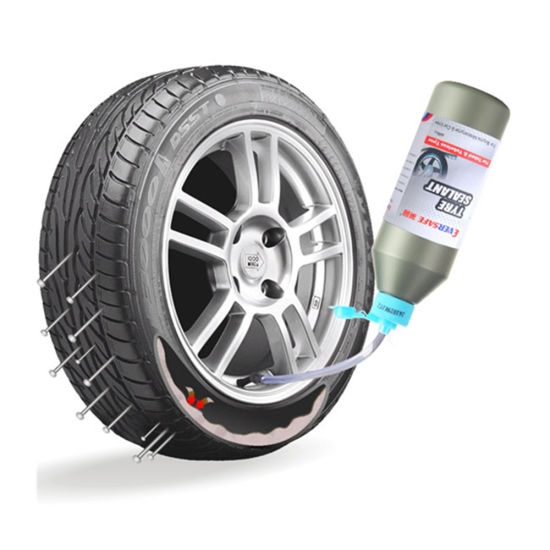 But such materials can be used with fully flat tires.
But such materials can be used with fully flat tires.
Repair sealants can only be used in tubeless tires. In tires with chambers, their use is unacceptable, since such material will simply glue the cylinder to the inner surface, and the wheel will become unusable.
There are a lot of tools for repairing punctured wheels on the market. In order to attract a potential buyer, manufacturers prescribe "tasty" properties to their products. But, if we put aside all the marketing tricks, to select the optimal tool, you should pay attention to the following characteristics.
Firstly, this is the purpose of the material. Aerosol wheel sealants, unlike those sold in bottles, have the additional function of increasing the pressure inside the tire. In terms of efficiency, it is impossible to say exactly which composition is better, but the ability to increase tire pressure can be indispensable, especially in cold or rainy weather.
The second is the operating temperature range of the sealant, namely frost resistance.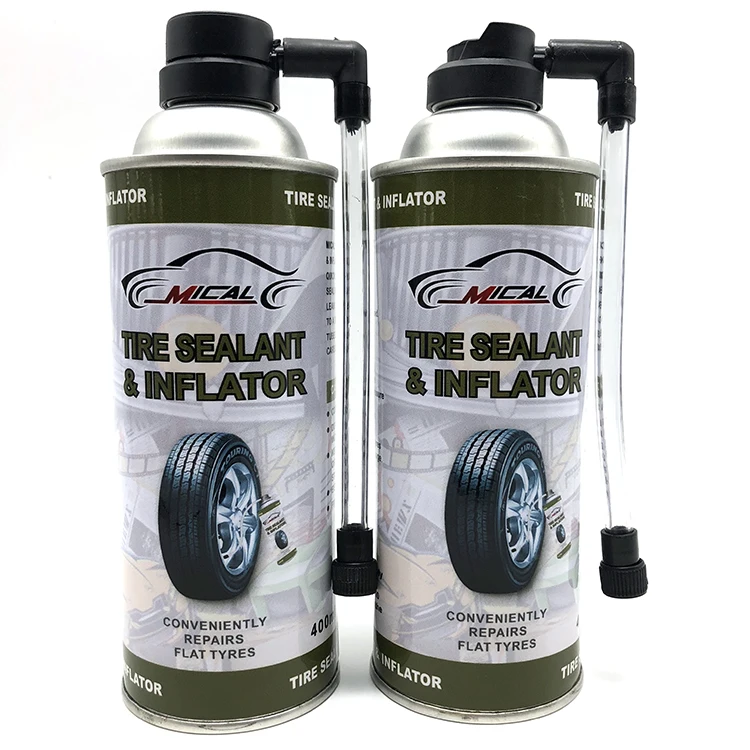 At negative temperatures, some compounds crystallize, lose their properties and become completely useless.
At negative temperatures, some compounds crystallize, lose their properties and become completely useless.
An important role is played by the volume of the sealant. For example, 300 ml of spray is enough to eliminate a puncture in a small car tire, but this is not enough to repair an SUV wheel. Therefore, the dimensions of the installed tires should be taken into account.
This information is contained on the label or instructions for use.
Do not forget about the types of tires installed on the car. Different sealants are used for tubeless and tube tires, but there are also universal compounds that are suitable for both types.
You also need to consider the number and size of punctures. Sealants can repair up to 6 punctures at the same time. At the same time, no composition will close up holes larger than 1 cm.
In addition to the above nuances, there are some difficulties that may arise when using a sealant.

Remember that the effect of tire adhesives is short-lived. Depending on the material, a retreaded wheel can be driven from 10 to 20 kilometers at a speed not exceeding 40-50 km/h.
To eliminate lateral damage with the help of such sealants will not work. It's all about centrifugal force, due to which the composition remains only in the projector area, and does not flow onto the side surfaces. Also, do not use sealants if the wheel is deformed.
If you are using aerosols that contain flammable gases, then the wheels should not be inflated with air. During driving, the rubber heats up and the mixture inside can ignite and explode.
Repairing a wheel with sealants is not a difficult procedure. The main thing is to follow certain rules that depend on the material used.
First you need to remove the object that caused the puncture or, if it is not there, find a hole. Then you need to turn the wheel so that the damage is on top.